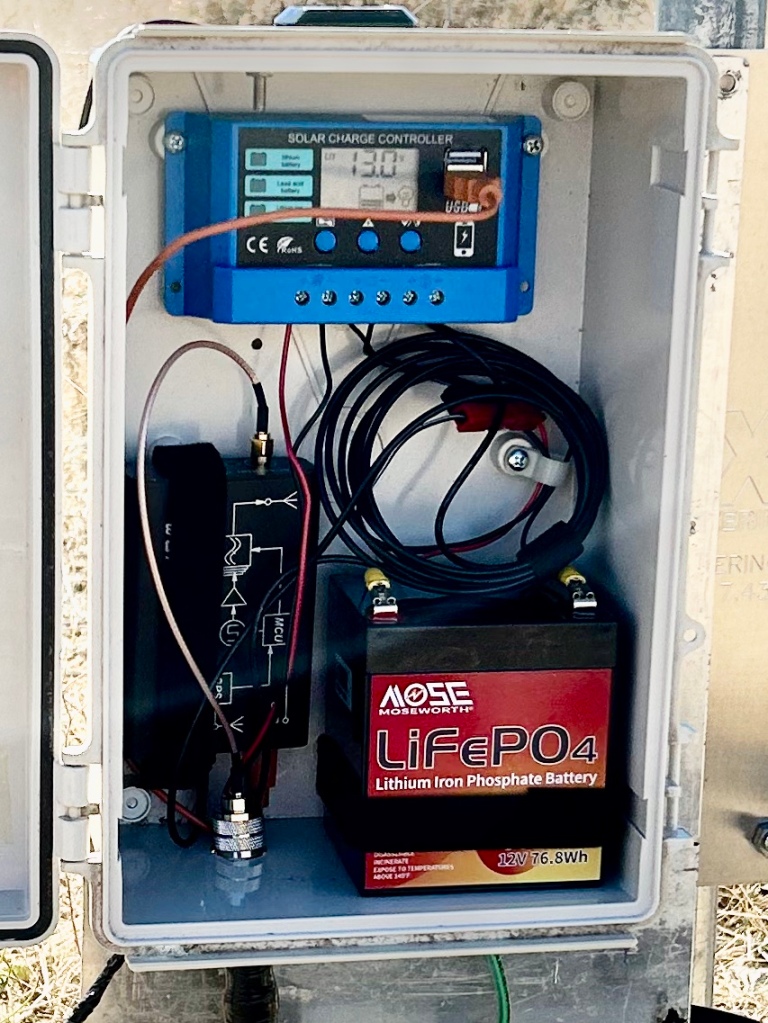How far can 1/5 watt reach? Here is proof. This is a screenshot of the last 24 hours showing stations that have received the 200 milliwatt (1/5 watt) signal from Colorado and posted it to WSPRnet.org. The transmitter is a ZachTek and the antenna is a trap vertical.

Reports from Reunion Island and Antartica are astonishing, but Europe is saturated and there are plenty of reports from Asia and Australia, too. All with 1/5 watt!
Why do we care? Why is WSPR important? Knowing what bands are open to what parts of the world instantly from our own location overcomes at least two shortcomings. There is no reliance on a packet cluster and there is no reliance on prediction software. WSPR shows exactly what direction to point transmit antennas in real time.
The ZachTek transmitter is described in the September, 2022 QST p 44. More information is shown at the ZachTek website.
Installation

Above is the enclosure holding the ZachTek on the left, the solar charge controller, and a battery. The ZachTek requires 5 volts. Conveniently, the charge controller has a USB jack built into it which makes it easy to plug the USB cable in directly from the ZachTek.
The ZachTek draws 3 amp-hours a day. Allowing for two cloudy days in a row, the ZachTek needs to have about 9 amp hours of battery capacity. Being outside, the battery also needs the ability to withstand temperature extremes. Lithium is not the best choice because of it’s charging restriction below freezing. A much better choice is the AGM lead acid battery. This installation has worked all winter using a 35 AH AGM battery in an external battery box. The LiFePO4 battery in the picture has been removed. Here is a look at the antenna which is a Hustler 6BTV trap vertical for 40, 30, 20, 15, and 10 meters. Barely visible at the bottom is the wire fencing lying on the ground serving as radials, held in place by concrete blocks.

Next, the 10 watt solar panels (which actually provide about 9 watts each). That’s 18 watts total per hour on a sunny day, or about .75 amp-hours. Multiplying .75 AH times 5 hours of peak sun results in 3.75 AH. A perfect design for the required 3 AH per day. To restore the battery after 2 cloudy days requires 9 AH or 12 hours of sun, needing help from a second day of sunshine. Over the 2023-2024 winter the system has not gone down. The panels are placed 50 feet away from the antenna to avoid interfering with the rf signal.
Wish List
It would be nice to have more bands, specifically 6 meters and 160 meters. Plans are in the works to use a pair of Yeasu FT-817’s. One could drive a M2 6m Halo and the other could drive the 160 meter decommissioned vertical.
Limitations in general include the fact that our signal will only be spotted from locations where there is a WSPR reporter. No reporter, no report. Our signal may be reaching many parts of the world that we will never know about because there is no one with a WSPR reporting station. One answer to that dilemma is provided by Jose, CT1BOH. In a talk given on QSO Today and available on his QRZ page Jose points out currently the most active mode by far is FT8. Use the various options to customize PSKReporter and have the most ideal real time propagation tool available. Easier than putting up a WSPR station but it takes away the ability to brag about reaching Reunion Island with 1/5 watt.
